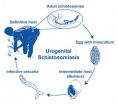(Press-News.org) EAST LANSING, Mich. — A new fuel-cell concept, developed by an Michigan State University researcher, will allow biodiesel plants to eliminate the creation of hazardous wastes while removing their dependence on fossil fuel from their production process.
The platform, which uses microbes to glean ethanol from glycerol and has the added benefit of cleaning up the wastewater, will allow producers to reincorporate the ethanol and the water into the fuel-making process, said Gemma Reguera, MSU microbiologist and one of the co-authors.
"With a saturated glycerol market, traditional approaches see producers pay hefty fees to have toxic wastewater hauled off to treatment plants," she said. "By cleaning the water with microbes on-site, we've come up with a way to allow producers to generate bioethanol, which replaces petrochemical methanol. At the same time, they are taking care of their hazardous waste problem."
The results, which appear in the journal Environmental Science and Technology, show that the key to Reguera's platform is her patented adaptive-engineered bacteria – Geobacter sulfurreducens.
Geobacter are naturally occurring microbes that have proved promising in cleaning up nuclear waste as well in improving other biofuel processes. Much of Reguera's research with these bacteria focuses on engineering their conductive pili or nanowires. These hair-like appendages are the managers of electrical activity during a cleanup and biofuel production.
First, Reguera, along with lead authors and MSU graduate students Allison Speers and Jenna Young, evolved Geobacter to withstand increasing amounts of toxic glycerol. The next step, the team searched for partner bacteria that could ferment it into ethanol while generating byproducts that 'fed' the Geobacter.
"It took some tweaking, but we eventually developed a robust bacterium to pair with Geobacter," Reguera said. "We matched them up like dance partners, modifying each of them to work seamlessly together and eliminate all of the waste."
Together, the bacteria's appetite for the toxic byproducts is inexhaustible.
"They feast like they're at a Las Vegas buffet," she added. "One bacterium ferments the glycerol waste to produce bioethanol, which can be reused to make biodiesel from oil feedstocks. Geobacter removes any waste produced during glycerol fermentation to generate electricity. It is a win-win situation."
The hungry microbes are the featured component of Reguera's microbial electrolysis cells, or MECs. These fuel cells do not harvest electricity as an output. Rather, they use a small electrical input platform to generate hydrogen and increase the MEC's efficiency even more.
The promising process already has caught the eye of economic developers, who are helping scale up the effort. Through a Michigan Translational Research and Commercialization grant, Reguera and her team are developing prototypes that can handle larger volumes of waste.
Reguera also is in talks with MBI, the bio-based technology "de-risking" enterprise operated by the MSU Foundation, to develop industrial-sized units that could handle the capacities of a full-scale biodiesel plant. The next step will be field tests with a Michigan-based biodiesel manufacturer.
INFORMATION:
Michigan State University has been working to advance the common good in uncommon ways for more than 150 years. One of the top research universities in the world, MSU focuses its vast resources on creating solutions to some of the world's most pressing challenges, while providing life-changing opportunities to a diverse and inclusive academic community through more than 200 programs of study in 17 degree-granting colleges.
For MSU news on the Web, go to MSUToday. Follow MSU News on Twitter at twitter.com/MSUnews.
New, fossil-fuel-free process makes biodiesel sustainable
2014-05-21
ELSE PRESS RELEASES FROM THIS DATE:
Risky alcohol use in male-dominated industries
2014-05-21
New Rochelle, NY, May 21, 2014—The workplace can provide an ideal environment to implement support, well-being, and testing interventions aimed at reducing risky alcohol use among men. By targeting male-dominated industries, in particular, alcohol screening and prevention efforts may be effective in reducing alcohol use, according to a Review article in Journal of Men's Health, a peer-reviewed publication from Mary Ann Liebert, Inc., publishers. The article is available free on the Journal of Men's Health website.
A team of Australian researchers led by Nicole Lee, ...
Phase III clinical trial shows image fusion-guided biopsy significantly improves accuracy of prostate
2014-05-21
NEW HYDE PARK, NY – A recent study by investigators from LIJ Medical Center demonstrated that using magnetic resonance imaging (MRI) in men with an elevated prostate specific antigen (PSA) resulted in a prostate cancer detection rate that was twice as high as data reported in the March 1999 Prostate journal that analyzed men undergoing the standard 12-core biopsy with an elevated PSA. Physicians in the recent trial used a targeted approach to evaluate prostate cancer that combines MR imaging and transrectal ultrasound fusion guided prostate biopsy.
Given the limitations ...
Carnegie Mellon, Microsoft Research automate privacy compliance for big data systems
2014-05-21
PITTSBURGH—Web services companies, such as Facebook, Google and Microsoft, all make promises about how they will use personal information they gather. But ensuring that millions of lines of code in their systems operate in ways consistent with privacy promises is labor-intensive and difficult. A team from Carnegie Mellon University and Microsoft Research, however, has shown these compliance checks can be automated.
The researchers developed a prototype automated system that is now running on the data analytics pipeline of Bing, Microsoft's search engine. According to ...
Funny River Fire, Alaska
2014-05-21
According to the Alaskan Division of Forestry the Funny River fire was very active overnight (May 20) because of low humidity. Currently the fire is estimated to be near 7,000 acres and has reached Tustumena Lake. It is spreading east and west along the shore, is 10 miles long, and is about a mile wide with broadening at the lake shore. There have been no evacuations or reports of any structures lost.
Early this morning (May 21), flame lengths of 125 feet with erratic fire behavior were reported. Winds for today are forecasted to remain out of the north keeping the fire ...
A faster track to the tools that track disease
2014-05-21
Radioactivity is usually associated with nuclear fallout or comic-book spider bites, but in very small amounts it can be a useful tool for diagnosing diseases.
Small molecules containing a radioactive isotope of fluorine called "18F radiotracers" are used to detect and track certain diseases in patients. Once injected into the body, these molecules accumulate in specific targets, such as tumors, and can be visualized by their radioactive tag on a positron emission tomography (PET) scan. The 18F tags quickly decay so no radioactivity remains after about a day.
But there ...
PMS may spell menopause symptoms later -- but not hot flashes
2014-05-21
CLEVELAND, Ohio (May 21, 2014)—Having premenstrual syndrome (PMS) before menopause does not mean women will be troubled by hot flashes afterward. But they may face more menopause complaints other than hot flashes, such as trouble with memory and concentration, finds a new study published online in Menopause, the journal of The North American Menopause Society (NAMS).
The research team at the Helsinki University Central Hospital and Folkhälsan Research Institute in Helsinki, Finland, are the first to show a link between PMS and a worse quality of life after menopause. They ...
Scientist uncovers links connecting environmental changes with spike in infectious disease
2014-05-21
National Museum of Natural History scientist Bert Van Bocxlaer and an international team of researchers revealed that anthropogenic changes in Africa's Lake Malaŵi are a driving force behind the increase of urogenital schistosomiasis, a debilitating tropical disease caused by parasitic flatworms. Scientists estimate that 250 million people are affected by schistosomiasis worldwide, and 600 million more are at risk of contracting it. In some villages along the shorelines of Lake Malaŵi, 73 percent of the people and up to 94 percent of the schoolchildren are infected ...
Scaly gem discovered in South American cloudforests
2014-05-21
Field and laboratory work by Omar Torres-Carvajal from Museo de Zoología QCAZ, Pontificia Universidad Católica del Ecuador, and his former undergraduate student Simón Lobos has resulted in the discovery of a gem-looking new species of shade lizard from the cloudforests in northwestern Ecuador. This region is part of the 274,597 km2 Tumbes-Chocó-Magdalena hotspot that lies west of the Andes. The study was published in the open access journal ZooKeys.
Shade lizards (genus Alopoglossus) are widely distributed across tropical South America. They differ from most other lizards ...
Shattering past of the 'island of glass'
2014-05-21
A tiny Mediterranean island visited by the likes of Madonna, Sting, Julia Roberts and Sharon Stone is now the focus of a ground-breaking study by University of Leicester geologists.
Pantelleria, a little-known island between Sicily and Tunisia, is a volcano with a remarkable past: 45 thousand years ago, the entire island was covered in a searing-hot layer of green glass.
Volcanologists Drs Mike Branney, Rebecca Williams and colleagues at the University of Leicester Department of Geology have been uncovering previously unknown facts about the island's physical history.
And ...
The interruption of biological rhythms during chemotherapy worsen its side effects
2014-05-21
Patients receiving chemical treatment for cancer often suffer fatigue and body weight loss, two of the most worrying effects of this therapy linked to the alteration of their circadian rhythms.
The circadian system, better known as our biological clock, is responsible for coordinating all the processes that take place in our organism.
If it does not function correctly, what is known as a circadian disruption or chronodisruption, has for years been linked to an increased incidence of cancer, obesity, diabetes, depression, cognitive problems or cardiovascular diseases.
"Also, ...






